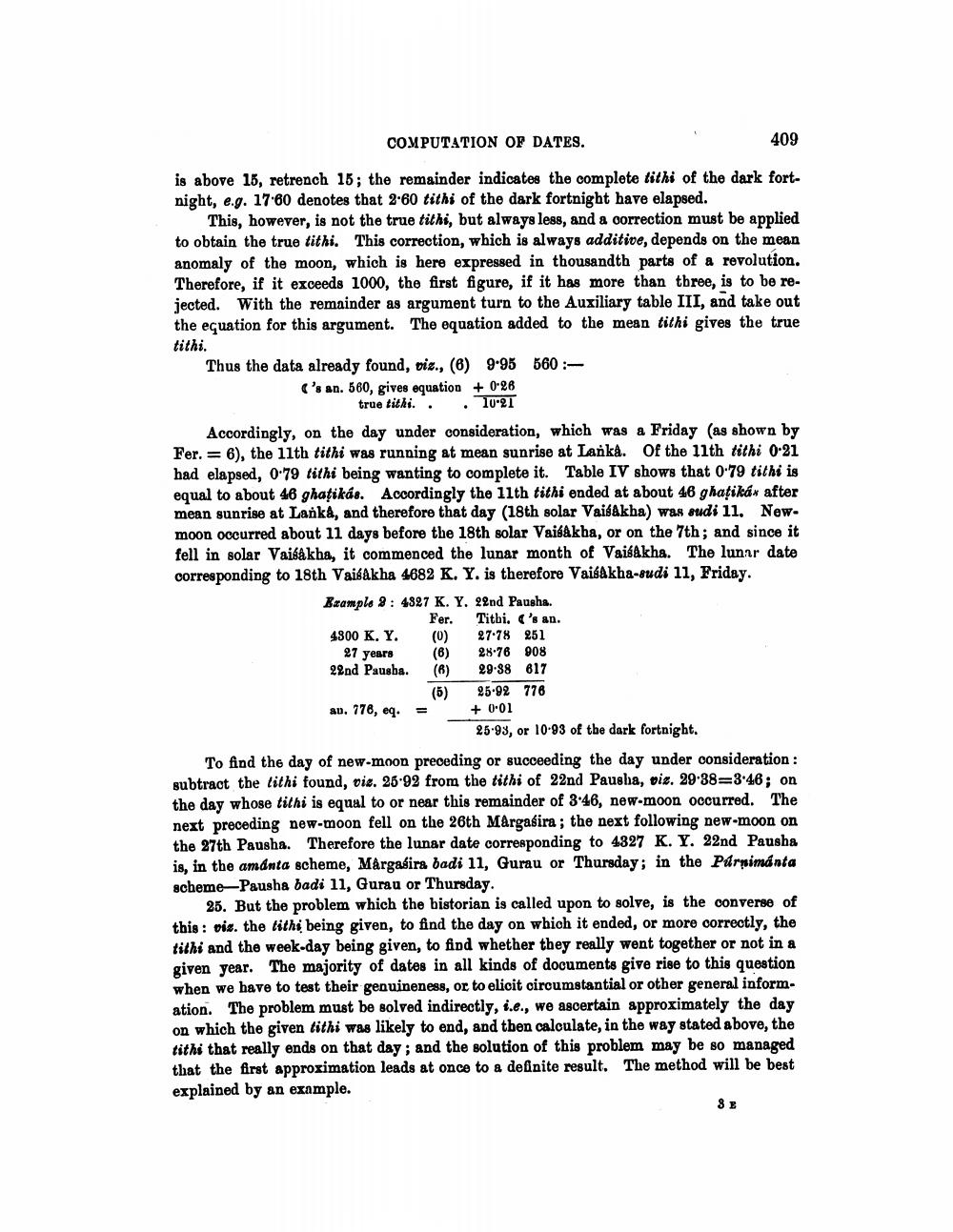________________
COMPUTATION OF DATES.
409
is above 15, retrench 15; the remainder indicates the complete tithi of the dark fortnight, e.g. 17.60 denotes that 260 tithi of the dark fortnight have elapsed.
This, however, is not the true tithi, but always less, and a correction must be applied to obtain the true tithi. This correction, which is always additive, depends on the mean anomaly of the moon, which is here expressed in thousandth parts of a revolution. Therefore, if it exceeds 1000, the first figure, if it has more than three, is to be rejected. With the remainder as argument turn to the Auxiliary table III, and take out the equation for this argument. The equation added to the mean tithi gives the true
Thus the data already found, viz., (6) 9.95 560 :
C's an. 560, gives equation + 0.26
true titki. . . 10-21 Accordingly, on the day under consideration, which was a Friday (as shown by Fer. = 6), the 11th tithi was running at mean sunrise at Lanka. Of the 11th tithi 0.21 had elapsed, 0·79 tithi being wanting to complete it. Table IV shows that 0·79 tithi is equal to about 46 ghatikás. A.coordingly the 11th tithi onded at about 46 ghatikán after mean sunrise at Lanka, and therefore that day (18th solar Vaisakha) was sudi 11. Newmoon occurred about 11 days before the 18th solar VaisAkba, or on the 7th; and since it fell in solar Vaisakha, it commenced the lunar month of Vaisakha. The lunar date corresponding to 18th Vaisakha 4682 K. Y. is therefore Vaisakha-sudi 11, Friday.
Example 3 : 4327 K. Y. 22nd Pausha.
Fer. Titbi, ('s an. 4300 K. Y. (0) 2778 251 27 years
(6) 28-76 908 22nd Pausba. (6) 29.88 617
(6) 25.92 776 ap. 778, eq. = + 0.01
25-93, or 10-93 of the dark fortnight. To find the day of new-moon preceding or succeeding the day under consideration : subtract the tithi found, vie. 26-92 from the tithi of 22nd Pausha, viz. 29-38=346; on the day whose tithi is equal to or near this remainder of 3.46, new-moon occurred. The next preceding new-moon fell on the 26th Margasira; the next following new-moon on the 27th Pausha. Therefore the lunar date corresponding to 4327 K. Y. 22nd Pausha is, in the amanta scheme, Margasira badi 11, Gurau or Thursday; in the Parpimdnta scheme Pausha badi 11, Gurau or Thursday.
25. But the problem which the bistorian is called upon to solve, is the converse of this: vig, the tithi being given, to find the day on which it ended, or more correctly, the tithi and the week-day being given, to find whether they really went together or not in a given year. The majority of dates in all kinds of documents give rise to this question when we have to test their genuineness, or to elicit circumstantial or other general information. The problem must be solved indirectly, i.e., we ascertain approximately the day on which the given tithi was likely to end, and then calculate, in the way stated above, the tithi that really ends on that day; and the solution of this problem may be so managed that the first approximation leads at once to a definite result. The method will be best explained by an example.




